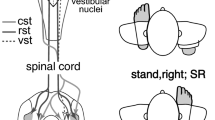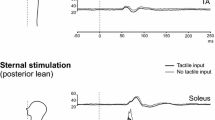Summary
EMG responses to toe-up tilt perturbations on a movable platform system were analysed in 86 children between the age of 12 months and 13 years. To assess the relative contribution of peripheral and central nerve conduction properties, a concomitant recording of the fastest efferent pathways in the central and peripheral motor system was made using non-invasive transcranial magnetic stimulation of motor cortex and peripheral nerve roots. This allowed the determination of the fastest downstream efferent connection times from motor cortex to lumbar motor neuron pools and to measure the fastest efferent conduction from these motor neuron pools to effector muscles in the lower leg. The sequence observed for stance stabilizing EMG responses was similar to that obtained in earlier studies with short latency (SL) and middle latency (ML) components occurring in the stretched triceps surae muscle and long latency (LL) responses occurring in the non-stretched tibialis anterior muscle. Homologous responses were also obtained in upper leg muscles, being recruited consistently later than those in lower leg muscles across all age groups. In the short latency range two different SL1- and SL2-responses were obtained in children of all age groups as well as in adult controls. Both the SL1- and the SL2-responses showed a flat developmental profile, reaching adult values between 20 and 30 months of age which correlated with that of the fastest efferents from lumbar motor neuron pools to leg muscles, i.e. the final motor path. ML-responses showed a steeper developmental profile. The LL-responses in TA muscle showed an even more prolonged maturational profile which fitted well with the development of central conduction times between motor cortex and the spinal motor neuron pools. The sum of the fastest possible afferent conduction times as estimated from somatosensory evoked potentials, and the fastest downstream efferent conduction times from motor cortex to effector muscles was smaller than the onset latencies of LL-responses. The resulting transcerebral processing time exceeded the sum of the fastest up- and downstream conduction times by up to 70 ms. This suggests a prolonged transcerebral processing loop for the proprioceptive input to LL-responses rather than a ‘transcortical’ loop.
Similar content being viewed by others
References
Ackermann H, Diener HC, Dichgans J (1986) Mechanically evoked cerebral potentials and long-latency muscle responses in the evaluation of afferent and efferent long-loop pathways in humans. Neurosci Lett 66: 233–238
Allum JHJ, Büdingen HJ (1979) Coupled stretch reflexes in ankle muscles and human posture stability. In: Granit R, Pompeiano O (eds) Reflex control of posture and movement. Progr Brain Res 50: 185–196
Allum JHJ, Mauritz KH, Vögele H (1982) Stiffness regulation provided by short-latency reflexes in human triceps surae muscles. Brain Res 234: 159–164
Barker AT, Freeston IL, Jalinous R, Merton PA, Morton HB (1985) Magnetic stimulation of the human brain. J Physiol 369: 3P
Berger W, Quintern J, Dietz V (1987) Afferent and efferent control of stance and gait: developmental changes in children. Electroenceph Clin Neurophysiol 66: 244–252
Conrad B (1978) The motor cortex as a primary device for fast adjustment of programmed motor patterns to afferent signals. Progr Clin Neurophysiol 4: 123–140
Cracco JB, Cracco RQ, Stolove R (1979) Spinal evoked potential in man: a maturational study. Electroenceph Clin Neurophysiol 46: 58–64
Darton K, Lippold OCJ, Shahani M, Shahani U (1985) Longlatency spinal reflexes in humans. J Neurophysiol 53: 1604–1618
Dick JPR, Cowan JMA, Day BL, Berardelli A, Kachi T, Rothwell JC, Marsden CD (1985) The corticomotoneurone connection is normal in Parkinson's disease. Nature 310: 407–409
Diener HC, Bootz F, Dichgans J, Bruzek W (1983) Variability of postural “reflexes” in humans. Exp Brain Res 52: 423–428
Diener HC, Dichgans J, Hülser P-J, Buettner U-W, Bacher M, Guschlbauer B (1984) The significance of delayed long-loop responses to ankle displacements for the diagnosis of multiple sclerosis. Electroenceph Clin Neurophysiol 57: 336–342
Diener HC, Ackermann H, Dichgans J, Guschlbauer B (1985) Medium- and long-latency responses to displacements of the ankle joint in patients with spinal and central lesions. Electroencephal Clin Neurophysiol 60: 407–416
Dunn HG, Buckler WSJ, Morrison GCE, Emery AW (1964) Conduction velocity of motor nerves in infants and children. Pediatrics 708–727
Evarts EV, Tanji J (1974) Gating of motor cortex reflexes by prior instruction. Brain Res 71: 479–494
Evarts EV, Tanji J (1976) Reflex and intended responses in motor cortex pyramidal tract neurons of monkey. J Neurophysiol 39: 1069–1079
Fetz EE, Cheney PD (1980) Postspike facilitation of forelimb muscle activity by primate corticomotoneuronal cells. J Neurophysiol 44: 751–772
Gamstorp I (1963) Normal conduction velocity of ulnar, median and peroneal nerves in infancy, childhood and adolescence. Acta Pediatr Scand 146: 68–76
Gottlieb, GL, Agarwal GC (1979) Response to sudden torques about ankle in man: myotatic reflex. J Neurophysiol 42: 91–106
Gottlieb GL, Agarwal GC (1980) Response to sudden torques about ankle in man. II. Postmyotatic reactions. J Neurophysiol 43: 86–101
Haas G, Diener HC, Bacher M, Dichgans J (1986) Development of postural control in children: short-, medium-, and long latency EMG responses of leg muscles after perturbation of stance. Exp Brain Res 64: 127–132
Hammond PH (1956) The influence of prior instruction to the subject on a apparently involuntary neuro-muscular response. J Physiol 132: 17–18
Hömberg V, Hennerici M (1987) Visual and somatosensory evoked potential mapping in patients with Huntington's disease. In: Barber C, Blum T (eds) Evoked potentials, III. Butterworth, London, pp 441–445
Hömberg V, Müller K, Lenard HJ (1989) Magnetoelektrische Stimulation von motorischem Kortex und Nervenwurzeln im Kindesalter. In: Weinmann HM (ed) Aktuelle Neuropädiatrie 88. Springer, Berlin Heidelberg New York, pp 168–172
Hömberg V, Lange HW (1990) Central motor conduction to hand and leg muscles in Huntington's disease. Movem Disorders 5: 214–218
Huttunen J, Hömberg V (1990) EMG responses in leg muscles to postural perturbations in Huntington's disease. J Neurol Neurosurg Psychiat 53: 55–62
Lee RG, Tatton WG (1975) Motor responses to sudden limb displacement in primates with specific CNS lesions and in human patients with motor system disorders. Can J Neurol Sci 2: 285–293
Marsden CD, Merton PA, Morton HB (1972) Servo action in human voluntary movement. Nature 238: 140–143
Marsden CD, Merton PA, Morton HB (1973) Is the human stretch reflex cortical rather than spinal? Lancet 759–761
Matthews PBC (1984) Evidence from the use of vibration that the human long-latency stretch reflex depends upon spindle secondary afferents. J Physiol 348: 383–415
Melvill-Jones G, Watt DGD (1971) Observations on the control of stepping and hopping movements in man. J Physiol 219: 709–727
Merton PA, Morton HB (1980) Stimulation of the cerebral cortex in the intact human subject. Nature 285: 227
Müller K, Hömberg V, Lenard H-G (1991) Magnetoelectric Stimulation of motor cortex and nerve roots in children: maturation of cortico-motoneural projections. Electroenceph Clin Neurophysiol (in press)
Murphy JT, Kwan HC, Wong YC (1979) Differential effects of reciprocal wrist torques on responses of somatotopically identified neurons of precentral cortex in awake primates. Brain Res 172: 329–337
Nashner LM (1976) Adapting reflexes controlling the human pos- ture. Exp Brain Res 26: 59–72
Nashner LM (1977) Fixed patterns of rapid postural responses among leg muscles during stance. Exp Brain Res 30: 13–24
Noth J, Matthews HR, Friedemann H-H (1984) Long latency reflex force of human finger muscles in responses to imposed sinusoidal movements. Exp Brain Res 55: 317–324
Radtke H-W (1969) Motorische Nervenleitgeschwindigkeit bei normalen Säuglingen und Kindern. Helv Paediat Acta 4: 390–398
Scholz E, Diener HC, Noth J, Friedemann H, Dichgans J, Bacher M (1987) Medium and long latency EMG responses in leg muscles: Parkinson's disease. J Neurol Neurosurg Psychiat 50: 66–70
Schmidt-Arendse H, Hömberg V (1990) Two components of short latency reflexes evoked by stance perturbation: influence of platform acceleration and vibration. In: Brandt et al (eds) Disorders of posture and gait. Thieme, Stuttgart, pp 140–143
Thomas JE, Lambert EH (1960) Ulnar nerve conduction velocity and H-reflex in infants and children. J Appl Physiol 15: 1–9
Thompson PD, Dick JPR, Asselman P, Griffin GB, Day BL, Rothwell JC, Sheehy MP, Marsden CD (1987) Examination of motor function in lesions of the spinal cord by stimulation of the motor cortex. Ann Neurol 21: 389–396
Wolpaw JR (1979) Electromagnetic muscle stretch strongly excites sensorimotor cortex neurons in behaving primates. Science 203: 465–467
Author information
Authors and Affiliations
Rights and permissions
About this article
Cite this article
Müller, K., Hömberg, V., Coppenrath, P. et al. Maturation of lower extremity EMG responses to postural perturbations: relationship of response-latencies to development of fastest central and peripheral efferents. Exp Brain Res 84, 444–452 (1991). https://doi.org/10.1007/BF00231468
Received:
Accepted:
Issue Date:
DOI: https://doi.org/10.1007/BF00231468




